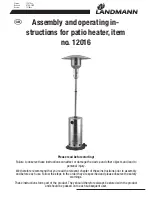
24
ances shall not terminate over public walkways or
over an area where condensate or vapor could
create a nuisance or hazard or could be detrimen-
tal to the operation of regulators, relief valves, or
other equipment. Where local experience indi-
cates that condensate is a problem with Category
I and III appliances, this provision shall also apply.
8. Locate and guard vent termination to prevent acci-
dental contact by people or pets.
9. DO NOT terminate vent in window well, stairwell,
alcove, courtyard or other recessed area.
10. DO NOT terminate above any door, window, or
gravity air intake. Condensate can freeze, causing
ice formations.
11. Locate or guard vent to prevent condensate from
damaging exterior finishes. Use a rust resistant
sheet metal backing plate against brick or mason-
ry surfaces.
12. DO NOT extend exposed vent pipe outside of
building. Condensate could freeze and block vent
pipe.
US Installations
Refer to latest edition of the National Fuel Gas Code.
Vent termination requirements are as follows:
a) Vent must terminate at least four (4) feet below,
four (4) feet horizontally, or one (1) foot above any
door, window or gravity air inlet to the building.
b) The vent must not be less than seven (7) feet
above grade when located adjacent to public walk-
ways.
c) Terminate vent at least three (3) feet above any
forced air inlet located within ten (10) feet.
d) Vent must terminate at least four (4) feet horizon-
tally, and in no case above or below unless four (4)
feet horizontal distance is maintained, from elec-
tric meters, gas meters, regulators, and relief
equipment.
e) Terminate vent at least six (6) feet away from adja-
cent walls.
f) DO NOT terminate vent closer than five (5) feet
below roof overhang.
g) The vent terminal of a direct vent appliance with
an input over 50,000 BTUH per hour shall require
a 12-inch vent terminal clearance.
h) Terminate vent at least one (1) foot above grade,
including normal snow line.
i) Multiple direct vent installations require a four (4)
foot clearance between vent caps.
Installations in Canada
Refer to latest edition of CAN/CGA-B149.
A vent shall not terminate:
a) Directly above a paved sidewalk or driveway
which is located between two single family
dwellings and serves both dwellings.
b) Less than 7 ft. (2.1m) above a paved sidewalk or
paved driveway located on public property.
c) Within 6 ft. (1.8m) of a mechanical air supply inlet
to any building.
d) Above a meter/regulator assembly within 3 ft.
(914mm) horizontally of the vertical center-line of
the regulator.
e) Within 6 ft. (1.8m) of any gas service regulator
vent outlet.
f) Less than 1 ft. (305mm) above grade level.
g) Within the 3 ft. (914mm) of a window or door which
can be opened in any building, any non-mechani-
cal air supply inlet to any building or the
combustion air inlet of any other appliance.
h) Underneath a verandah, porch or deck, unless
(i) the verandah, porch or deck is fully open on a
minimum of two sides beneath the floor, and
(ii) the distance between the top of the vent termi-
nation and the underside of the verandah,
porch or deck is greater than 1 ft. (30 cm).
Summary of Contents for HI DELTA HD401
Page 36: ...36 WIRING DIAGRAM MODELS HD101 HD151 TYPE WH...
Page 37: ...37 WIRING DIAGRAM MODELS HD101 HD151 TYPE H...
Page 38: ...38 WIRING DIAGRAM MODELS HD201 HD401 TYPE WH...
Page 39: ...39 WIRING DIAGRAM MODELS HD201 HD401 TYPE H...
Page 50: ...50...
Page 51: ...51...
















































